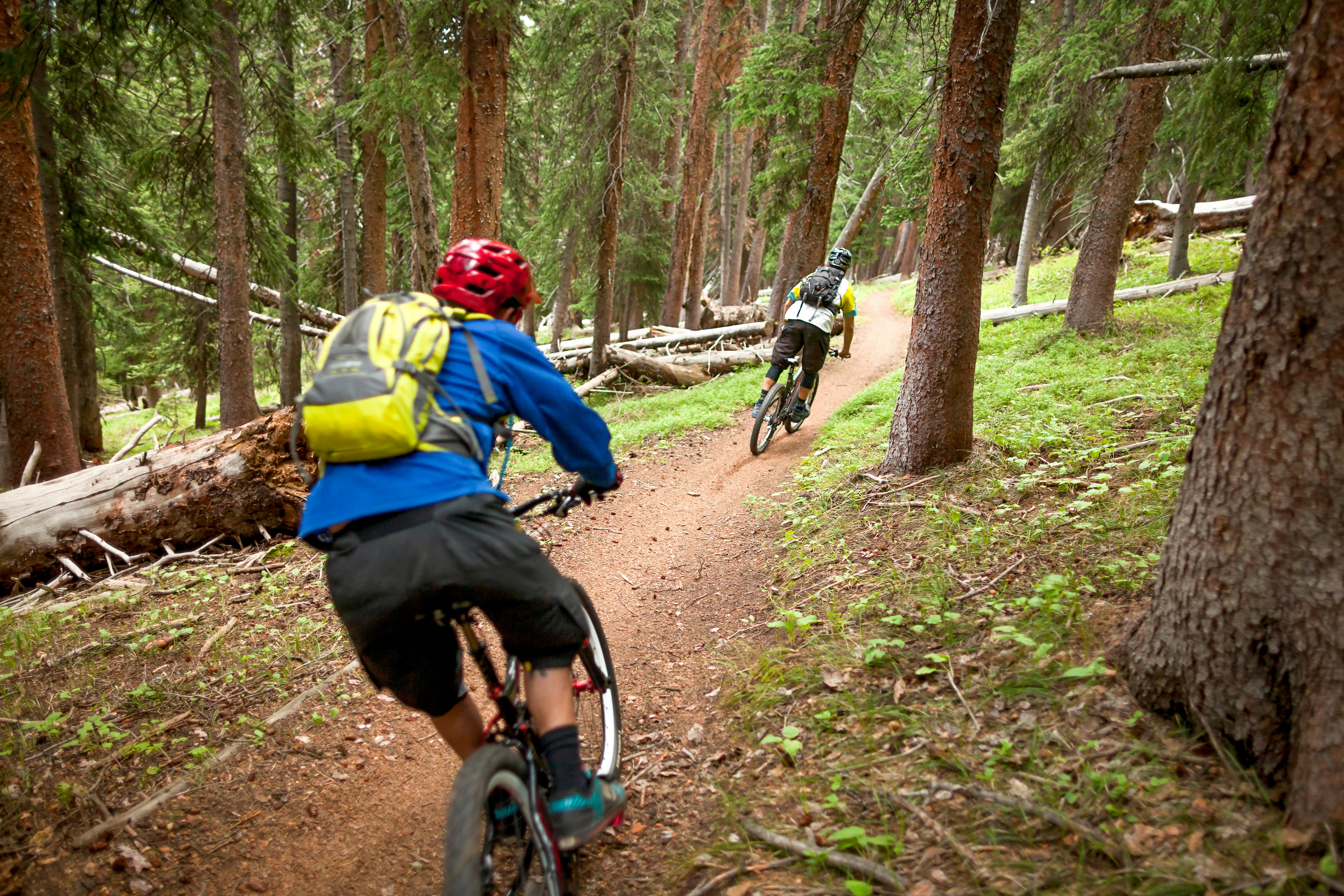

Come winter or summer, it's easy to get up into the mountains in Vail © Daniel Milchev / Getty Images
With its small footprint and free local buses, the resort town of Vail is super easy to navigate. Located along the banks of Gore Creek in the Rocky Mountains, this popular base for winter and summer thrills has hotels, shops, restaurants, bars and community gathering spaces all centrally located at the base of the slopes.
At the Vail Ski Resort, gondolas and chairlifts come right into town, and travelers can easily walk, bike or take a free bus to reach pretty much everywhere in the Vail Valley. Whether you come for skiing, hiking, mountain biking or just admiring the views, here are the best ways to get around.
The center of Vail is car-free – great news for pedestrians!
Vail is a very pedestrian-friendly destination, thanks to the car-free streets of Lionshead and Vail Village. Walking paths connect many of the shops, restaurants and hotels in town, and Vail's extensive recreation trails make it safe and enjoyable to walk from village to village and beyond. Even walking beside the road is enjoyable thanks to wide sidewalks and slow speed limits, and you can get high into the hills for summer hikes on the Vail gondola.
Free buses go pretty much everywhere
Vail’s commendable free bus system is a pocket-friendly and convenient way to get around while you’re vacationing in the mountains. The service is free all year long and there are routes and stops located all over town, making it quick and easy to get nearly everywhere via bus.
You can track buses in real-time and get updated arrival times and important announcements via the RideVail Transit website. Adding to the feel-good factor, Vail has started adding electric buses to its fleet and aims to go all-electric by 2032 – just one of many environmental policies that led to Vail being declared the world's first sustainable mountain resort in 2018.
Buses that serve outlying routes are equipped with bike racks – handy if you’re planning to hit the region’s many mountain bike trails or do some road cycling in the mountains. Passengers can also bring skis and snowboards, so taking the bus is a stress-free way to start and end a fun day on the slopes. It's also handy after dark if you plan to have a few apres-ski drinks.
Riding the bus also removes the hassle of trying to find a parking space at the trailheads dotted around Vail; parking areas tend to fill up quickly, especially during the busy summer season. The town encourages visitors to take the bus to trailheads rather than driving as part of the Bus to Hike It initiative.
To travel further afield to destinations such as Leadville, Minturn, Eagle-Vail, Avon, Edwards, Eagle and Gypsum, take advantage of the regional ECO Transit bus service, with fares starting at $4. Some Vail Valley hotels, such as Highline Vail and Grand Hyatt Vail, run special shuttle buses into the middle of Lionhead and Vail Village for guests.

Bike paths zigzag through Vail
Whether you’re heading out for a day of mountain biking, or just cruising from place to place, exploring Vail on two wheels is a breeze – and a fun, immersive way to enjoy Vail’s beautiful scenery. The town has more than 15 miles of paved, multi-use recreation paths that can help you get anywhere you need to go, with bike racks conveniently located all over town.
Mountain biking enthusiasts can explore 343 miles (552km) of trails through the mountains near Vail; see the Vail Ski Resort website for a map and information on "bike hauls" by gondola to the tops of the trails. To rent a bike, head to one of the many bike rental shops in town, such as Evoke Outdoors, Wheel Base and Vail Sports.
Vail is a park-and-stroll kind of place
With activities and amenities close at hand, many visitors to Vail simply park their car at their hotel or vacation rental and walk, bike or take the bus everywhere. Vail is a great place to visit for a car-free vacation, just one of the things that earned the resort its sustainable accreditation. This said, having a vehicle can be handy for reaching other towns in the valley or heading out for adventures in the vast wilderness that surrounds Vail.
The main access route to Vail is Interstate 70, the large, multi-lane highway that runs east-west across the entire state of Colorado. The town straddles I-70 and everything within Vail is just a few minutes from the interstate. The I-70 also provides easy access to other towns in the valley and some of the trailheads and campgrounds.

Parking in Vail
Many Vail hotels offer on-site valet or self-parking for a fee (usually around $45) and some condo buildings and vacation rentals offer complimentary parking for a limited number of vehicles. With the excellent walking and bike trails and free buses, may end up leaving your car parked for the whole time you're in Vail.
There are also two public parking structures (multi-level car parks) in Vail, plus several free satellite parking lots that are serviced by the free bus system. Head to the free overflow parking area on South Frontage Road when the public parking areas fill up.
Parking rates vary depending on the season in Vail. In the winter, parking in the Vail Village and Lionshead structures is free for the first two hours; prices then range from $10 to $50 depending on how long you stay. Vehicles entering after 3pm and before 3am can park for free.
In the summer, parking is free during daytime hours and there's a $35 charge for overnight parking. To help you plan your parking strategy, the Town of Vail posts handy live parking updates that show the number of vacant spots in the town's managed parking areas. There are charging stations for electric vehicles in the Vail Village and Lionshead parking structures.
Rental cars, taxis and rideshares in Vail
Eagle County Regional Airport, the main airport serving Vail, has all the usual car rental companies: Alamo, Avis, Budget, Dollar, Hertz, National, Thrifty and Go Rentals. Some travelers prefer to fly into Denver International Airport and rent a car there for the 120 mile (193km) drive to Vail.
The Vail Valley also has taxi and limo services for transportation to and from the airport, and for getting around town. There are some Uber and Lyft drivers in Vail, but not many, so finding a ride isn’t always guaranteed.
Accessible transportation in Vail requires some advance planning
For travelers with disabilities, getting around in Vail can be a challenge, but the resort is a popular hub for adaptive skiing in winter. At any time of year, the town offers a free paratransit service for people with mobility issues who can't use the ordinary bus system, but you must apply in advance. Fill out a paratransit application form and get it certified by a doctor, then request a ride at least one day ahead.
There are plenty of accessible parking spots in the Vail Village and Lionshead parking structures, plus a few two-hour spaces in various locations throughout Vail Village. Some of Vail’s paved paths are wheelchair-friendly, but they can be challenging for wheelchair users because of the hilly terrain and high elevation.
The Vail and Beaver Creek ski areas offer adaptive skiing and snowboarding lessons with some financial assistance available from Access Unbound, a Vail-area foundation that supports children and adults with disabilities. For more information on accessible travel, check out Lonely Planet’s accessible travel resources.
You may also like:
Whimsical autumn adventures abound in Vail
Connect to nature no matter the season in Vail, Colorado
Vail is a melting pot of international cuisine














